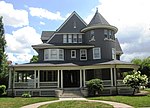Grecian Shelter

Grecian Shelter, was designated as Croquet Shelter on the original plans. It was also referred to as the Prospect Park Peristyle. The building is situated near the southern edge of Prospect Park in Brooklyn, New York and is a peristyle with Corinthian columns. Constructed by McKim, Mead and White in 1905, this peristyle was built on the site of the 1860s-era Promenade Drive Shelter along the southwest shore of the Prospect Park Lake. The Prospect Park Peristyle is designed in the Renaissance architectural style. It consists of a raised platform located two steps above ground level; the platform is covered by a rectangular colonnade with 28 Corinthian marble columns, each with square piers. An entablature of terracotta runs atop the structure. The building was constructed as a temporary refuge from rain and sun.Grecian Shelter was rehabilitated in 1966 and listed on the National Register of Historic Places in 1972. The peristyle is also a New York City designated landmark, having been declared as such on December 10, 1968.
Excerpt from the Wikipedia article Grecian Shelter (License: CC BY-SA 3.0, Authors, Images).Grecian Shelter
East Drive, New York Brooklyn
Geographical coordinates (GPS) Address External links Nearby Places Show on map
Geographical coordinates (GPS)
| Latitude | Longitude |
|---|---|
| N 40.653611111111 ° | E -73.9675 ° |
Address
Peristyle
East Drive
11215 New York, Brooklyn
New York, United States
Open on Google Maps








